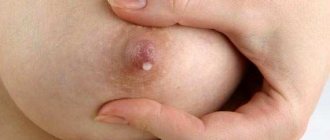In what cases are the mammary glands pulled?
Pulling the mammary glands with a towel or diaper was a common way to stop lactation. But modern pediatricians and gynecologists insist that this physiological process must occur gradually. The duration of feeding will decrease gradually as the child ages. Gradually the volume will decrease.
There are a number of reasons why dragging is necessary due to unforeseen circumstances.
Such reasons include:
- Illness of the mother - a doctor can urgently indicate an urgent need to complete lactation. Most often, such situations arise when the disease negatively affects the quality of milk, and this can harm the baby. It will be necessary to stop feeding if the mother takes medications for a long time. If medications are compatible with breastfeeding, you can temporarily stop breastfeeding by expressing milk daily.
- Going to work.
- Urgent departure.
Tugging will not reduce milk production. This process is completely controlled by hormonal changes in a woman’s body. The hormones prolactin and oxytocin are responsible for the appearance of milk. They are produced more actively at night.
If you draw breast milk, it will not reduce the amount of hormones entering the blood. Only the lobes of the mammary glands are blocked so that they do not fill with milk.
Pediatricians strongly recommend feeding your baby until he or she is 12 months or older. This is required for correct and complete physiological and intellectual development and the formation of a strong natural protective barrier - the immune system.
Technique for applying a bandage to the mammary gland
Knowledge of how to tighten the mammary glands so that milk disappears will make this process absolutely painless. The main condition for constriction is tight fixation of the bandage .
Pulling must be done in stages.
- Take a strong cotton fabric, a sheet, a diaper or a wide towel.
- We apply a fabric bandage to the glands from the armpits to the lower ribs.
- We tie the ends of the fabric tightly between the shoulder blades.
- We make sure that the fabric fits tightly and that the woman does not feel pain when tightening the knot.
At first, it is difficult to transfer breast milk on your own; assistants will be required. With the help of another person, the bandage can be secured more tightly.
Information on how to transfer breast milk will be provided in full in the video below.
Is it worth stopping lactation by dragging?
Breast milk transfer is a serious procedure that pediatricians recommend only in extreme cases.
pros
There are no positive aspects to this procedure. It is recommended to feed the child with breast milk until 12 months. This helps build his immunity.
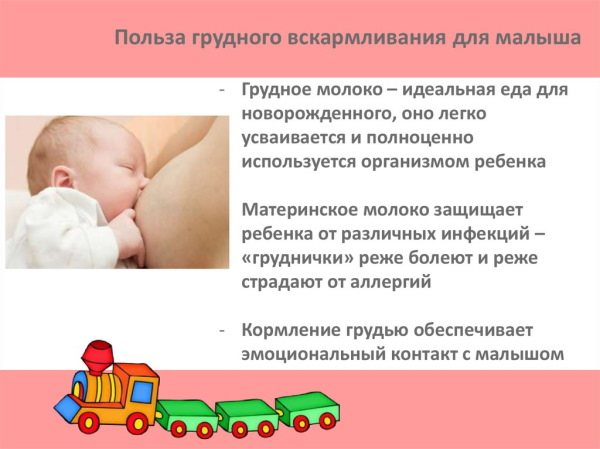
The only advantage of the procedure will be a situation where further feeding is dangerous for the child’s health. If the mother has an infection that can be transmitted to the baby through milk.
Minuses
The tugging procedure speeds up the cessation of milk production. But mammologists argue that this method should be used only in extreme cases, as it is associated with serious risks.
The consequences may be:
- The appearance of swelling, pronounced tenderness of the mammary glands. The chest becomes hard, any touch causes severe pain.
- With strong compression, the soft tissue of the mammary gland can be injured.
If a woman experiences a feeling of discomfort, the bandage must be immediately removed and the remaining milk must be completely expressed. If you ignore these sensations, the condition may worsen.
Why is breast tightening dangerous?
Pulling breast milk without following the rules can lead to serious consequences. One of them is the development of mastitis. Blockage of milk flow leads to stagnation. Because of this, lactostasis occurs, painful sensations appear in the chest area, and the temperature rises sharply.
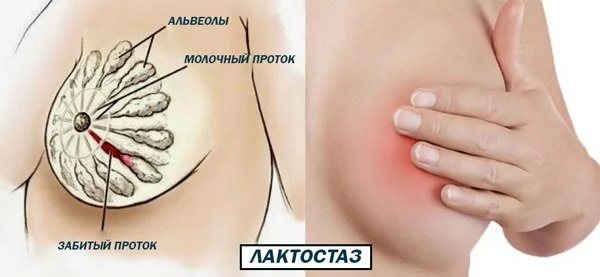
It manifests itself as lumps in the chest area. They need to be thoroughly rubbed until the clot completely disappears. This manifestation should not be ignored, as infectious mastitis may develop. In advanced conditions, women are prescribed surgical intervention
Step-by-step instructions for breast tightening
Tugging must be carried out in accordance with the rules so that breast milk does not stagnate in the mammary glands and mastitis does not develop.
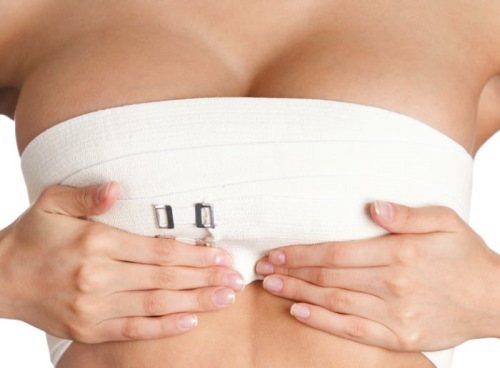
To carry out the procedure, you need to perform the following steps:
- Take a warm bath or shower and do a relaxing breast massage.
- Take a wide sheet or towel.
- The bandage is applied to the chest, completely covering the area of the body from the ribs to the armpits.
- The ends of the material must be tied tightly behind the back at the level of the armpits.
It is important that the woman does not experience pain when pulling. Only soft breasts can be compressed. You must first have the child empty it or carefully express the remainder.
While tugging, you need to reduce the amount of fluid you drink and actively engage in physical activity, this contributes to increased sweating and decreased lactation. You should not take a hot shower until the milk has completely burned off. Warm water will cause the milk ducts to warm up, which will only increase the volume of milk.
How to properly tie breast milk (breast bandage) to prevent lactation
Sooner or later, every nursing mother has to complete lactation.
It’s good if this happens naturally - the amount of milk produced gradually decreases, and as the baby grows older, he starts breastfeeding less and less until he no longer needs it at all.
However, in some cases, the mother decides to resort to a measure of forced reduction of lactation - breast tightening. Let's figure out when this method is relevant, what its pros and cons are.
When and why are breasts tightened?
It is recommended to stop lactation naturally
Breast tightening is considered an undesirable way to stop lactation, which was popular during Soviet times. Modern doctors insist on the physiological cessation of lactation when the child is at least 1 year old and his need for breast milk decreases.
In this case, the number and duration of feedings are gradually reduced, and breast milk becomes less and less until the glands stop filling altogether. However, modern breastfeeding specialists may recommend re-drawing in the following cases:
- Mom's illness.
Only a doctor can recognize the need to complete breastfeeding for medical reasons, having established a diagnosis that is incompatible with lactation, when breast milk can be dangerous to the health of the baby. These diseases include AIDS and infectious mastitis. It is also necessary to stop lactation if you are taking medications for a long time that are incompatible with breastfeeding.Fortunately, today there are many medications that do not require completion of breastfeeding. It may be worth considering the option of temporarily stopping lactation for the period of treatment, if it is short-lived. Then it is recommended to express milk, and after treatment try to resume breastfeeding.
- The need to quickly complete the GW.
Pediatricians strongly recommend breastfeeding your baby until he reaches the age of 1 year and beyond. This is necessary for the qualitative physiological and intellectual development of the child and the formation of strong immunity. If there is a need to end breastfeeding for objective reasons (departure, mother going to work, etc.), it may be worth resorting to breast tightening as an auxiliary way to complete breastfeeding.
From a physiological point of view, breast tightening does not lead to a decrease in milk production. This process is controlled by the brain, and is stimulated by hormonal changes in the body. The hormones prolactin and oxytocin are released in response to the baby's gentle hugs and touching the nipples, especially at night. Accordingly, the presence of a tight bandage cannot affect a woman’s hormonal levels.
But the experience of several generations of women who have resorted to this method shows its effectiveness. Due to tugging, the lobules of the glands into which milk flows are blocked, the breasts fill more slowly, which can ultimately lead to suppressed lactation.
A tight bandage on the chest also acts as a frame that supports the full breast, providing the woman with additional comfort and reducing pain.
Possible harm and precautions
The breast must be completely tightened, otherwise stagnation of milk will form in the free ducts
Breast constriction can lead to many serious problems if the correct technique, timing of dressing, and breast preparation rules are not followed . The most serious are the development of lactostasis (milk stagnation) and mastitis (inflammation in the mammary gland).
If you have problems stopping lactation, you should seek help from a specialist. Perhaps the doctor will prescribe medications that suppress lactation. Do not rush to resort to the dressing method, try to reduce lactation naturally first, and instead of pulling, wear a tight-fitting but comfortable underwire bra.
You shouldn’t expect that the milk will “burn out” on its own; you just need to tighten your breasts and wear the bandage for as long as possible. Such actions are dangerous and can lead to serious complications, inflammatory processes in the mammary gland, and mastitis.
Remove the bandage if you feel discomfort or pain in the chest, and express the amount of milk necessary to relieve the condition. This will avoid stagnation and possible inflammation in the ducts.
Do not overtighten your breasts if there are lumps in them or if you experience pain when pressing.
Recommendations for correct completion of breastfeeding
Don't rush to tighten your breasts, try wearing a tight-fitting bra
Take note of these important tips:
- do not stop lactation suddenly - gradually (over 1-2 weeks) reduce the frequency and time the baby stays at the breast, make sure that he eats other types of food and is full;
- if areas of compaction appear in the chest, redness, or an increase in body temperature above normal, immediately go to the hospital;
- do not apply warm compresses or heat the bandaged breast;
- reduce the amount of fluid consumed;
- go in for sports, active physical activity will increase sweating and reduce the amount of milk produced;
- include in your diet decoctions of herbs that suppress lactation - sage, mint;
- Apply fresh cabbage leaves to your chest to eliminate discomfort.
According to the famous doctor Evgeniy Komarovsky, resorting to breast constriction is undesirable. To stop lactation, he recommends limiting fluid intake, eliminating foods and drinks that stimulate lactation, reducing breastfeeding, not expressing milk unnecessarily, and actively engaging in sports. If you still decide to tighten your breasts, this should be done not only during the day, but also at night.
Preparing for drag
Before tugging, it is recommended to feed the baby or express
Before breast transfer, you need to express a little milk, free the ducts so that the breast is soft.
To do this, follow the recommendations:
- take a relaxing bath or shower (the water should not be hot, this stimulates lactation) to make pumping easier;
- massage your breasts with your hands - this will allow you to develop glandular lobules for pumping;
- tighten your breasts after feeding or pumping - the glands should be soft;
- do not “empty” your breasts completely, this promotes the flow of even more milk;
- express using your hands rather than a breast pump to better control the process and evenly release the distant and near ducts.
Drag technique
A tight bandage on the chest should not cause pain
Breast tightening to stop lactation involves tightly tying the chest over the entire surface - from the height of the armpits to the lower border of the ribs. This is the only correct way. The following can be used as a dressing material:
- wide towel;
- sheet;
- piece of fabric;
- compression bandage;
- elastic bandage.
The material must be clean, made of breathable cotton fabric. To fix the bandage, you will need the help of another person; it is almost impossible to tighten the bandage and tie it on your own.
When planning to tighten your breasts, do the following:
- Place the central part of the cloth on the chest, fixing the mammary glands in a comfortable position.
- Depending on the length of the fabric, wrap the breasts in 1 or 2 layers and tighten them tightly enough to fix the mammary glands without causing pain.
- Tie the ends or secure with special fasteners if you are using an elastic bandage or bandage.
The duration of continuous wearing of the bandage is determined individually, usually this period is about 3 hours during the day.
If unpleasant sensations appear, the fabric is removed and the milk is expressed until the condition eases, when the breasts “rest”, they are tightened again.
Considering that hormones that stimulate lactation are actively released at night, it is recommended to apply a compression bandage throughout the night (if there is no pain).
: A lactation consultant on the dangers of breast dragging
Breast tightening is considered an outdated, risky, but effective method of suppressing lactation.
It should be resorted to in extreme cases, when the natural decrease in milk production lasts for a long time or cannot be achieved for other reasons.
To avoid possible problems, you need to tighten your mammary glands according to the rules, carefully monitoring the condition of your breasts and observing your own sensations.
- Lyudmila Morozova
Source: https://orebenke.info/posle-rodov/laktatsiya/kak-peretyanut-grudnoe-moloko.html
Is it possible to do without dragging?
Since drawing breast milk is associated with great risks for the woman and psychological trauma for the child, this method should be used only in extreme cases. If there is no immediate need to stop feeding due to maternal illness, milk production can be stopped gradually.
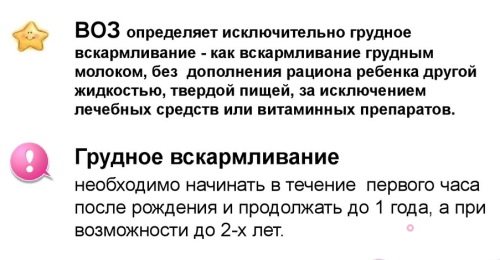
There are a number of rules for this:
- Replace one of the feedings during the day with a mixture; after a week, you can add 1 more meal with the mixture;
- as soon as the baby gets used to other food, you can remove breast milk before bedtime;
- Gradually, the woman's milk volume will decrease.
It is important to pay attention! There are certain periods in a child's life during which it is not recommended to wean him or her from the breast. The only exception will be if there is an urgent need for medical reasons.
It is undesirable to stop lactation in the following cases:
- If a child is sick, breast milk will help the body quickly cope with the virus and develop immunity. In addition, while sucking, the baby calms down faster.
- During teething or after vaccinations.
- During the hot summer period, when the child has an increased need for fluid.
It is not recommended to separate your baby if you are planning a move or a long trip that will be stressful. It is recommended to discuss everything related to breastfeeding with your doctor.
Myths about breast drag
- Bandaging means that the baby will be weaned immediately. This is only true if lactation is stopped for medical reasons; with a natural process, this will take about a week. It is best to feed your baby once a day and wear the bandage at night and for several hours during the day.
- In order for milk to stop being produced faster, it is better not to express it at all. In fact, it is very harmful to a woman's health. You need to express not completely, but until relief occurs, otherwise stagnation will form (lactostasis), and then mastitis.
- If you need to express milk, it is better to use a breast pump. On the contrary, doctors advise doing this only manually.
Modern pharmaceuticals suggest stopping breastfeeding through the use of medications. How many days will it take? Some drugs can stop the process literally within 24 hours. Naturally, this causes harm to the woman’s body.
Medicines affect the functioning of the endocrine system and brain. Their selection should be carried out only by the attending physician, who closely monitors the woman’s health.
Taking medications involves additionally expressing milk. Tugging with a bandage while taking medications is prohibited.

Breastfeeding specialists recommend wearing a wire-free bra during this period, which does not additionally compress the breasts.
Use of medications
There are a large number of medications that help quickly and effectively eliminate lactation. Before using them, it is recommended to consult a pediatrician.
| Drug name | Description |
| "Dostinex" | A drug that affects the production of the hormone prolactin. The drug is prescribed if it is necessary to stop lactation urgently. The effect appears within 2 days after taking the tablets. |
| "Bromocriptine" | The components of the drug are aimed at restoring the menstrual cycle and reducing lactation levels. It is important to note that the drug can increase blood pressure, so it is not recommended for women prone to hypertension. The result is achieved only on the 4th day of taking the medicine. |
| "Bromcamphor" | A non-hormonal drug that has a sedative effect. But you cannot take the medication if a woman has kidney or liver pathologies. The drug is prescribed only if it is not urgent to stop milk production. |
| "Utrozhestan" | A steroid drug that contains hormones identical to natural ones. They are aimed at suppressing milk production. |
When taking medications, it is necessary to express the remaining milk; it is strictly forbidden to give it to the child. During this period, the breasts are not tightened; you need to wear a tight bra that will provide good support.
The method of stopping lactation with medications should be used only in extreme cases, for example, when the mother is ill. They should only be prescribed by doctors after an examination. This will help avoid possible complications. It is important to understand that after taking a course of pills, it will no longer be possible to restore lactation.
Folk remedies to reduce lactation
Using herbal infusions and compresses, you can reduce milk production in a gentle way.
Herbal teas
Before completing breastfeeding, it is recommended to drink herbal infusions:
- Sage - 10 g of crushed leaves pour 300 ml of boiling water. The herb is infused for an hour. The entire volume must be drunk per day;
- Steam 10 g of mint leaves in 500 ml of boiling water. Divide the resulting volume of decoction into three times.

Lingonberry leaf is good for stopping the production of breast milk. 10 g of raw material is steamed in 300 ml of water. I drink the decoction gradually throughout the day. The next day you need to prepare a new product.
Herbal mixture with sage
Using sage when stopping breastfeeding is considered the most effective way. At home, you can prepare a decoction of sage, hop cones and walnut leaves.
To prepare you will need:
- 2 tbsp. sage;
- 2 tbsp. walnut leaves;
- 4 tbsp hop cones.
All components are poured with boiling water in a volume of 500 ml. You need to drink 100 ml of the decoction three times a day until milk production stops completely. Sage can be purchased in bags and brewed as tea. It is recommended to drink this remedy 2-3 times a day. The herb can also be purchased in capsule or tablet form and taken as directed.
If feeding has already completely stopped, drink tincture with sage. It acts much faster than teas and decoctions. Alcohol tincture is taken 30-50 drops 3 times a day. The product is diluted with water.
Compresses
You can apply compresses to the mammary glands no more than once a day. This will help reduce discomfort, pain, and relieve inflammation. Cabbage leaves are suitable for the procedure, onto which a few drops of sage essential oil are applied.
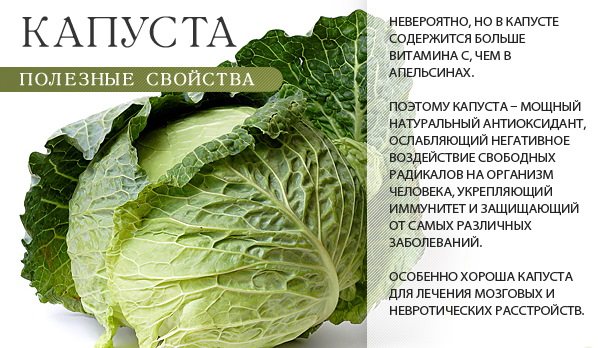
A camphor compress has a good effect. The oil is applied to the chest area with the exception of the nipples. The top of the chest needs to be insulated. The procedure must be carried out every 4 hours. The course of treatment is 3 days.
If a woman is experiencing severe chest pain, a cold compress can be applied. Any frozen item or pieces of ice will be useful for this. It is applied to the inflamed area through soft tissue. You can hold it for no more than 20 minutes so as not to chill your chest.
Myths about breast drag
There are many myths about the procedure that can lead to negative consequences. Women believe that they need to bandage the glands as tightly as possible and walk like this all day. But this is a huge misconception. Such actions will lead to the development of mastitis. The bandage only needs to be applied for a few hours, 2-3 times a day.
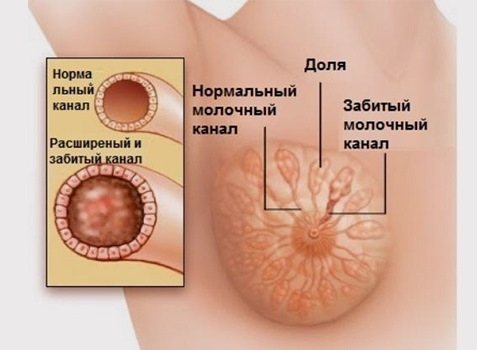
Drawing on breast milk can lead to stagnation and mastitis.
Most refuse to take medications, preferring to apply bandages. They believe that the drugs can cause breast cancer. Breast ligation is not a safe method, especially if carried out without medical supervision.
Tablets to stop lactation
Ideally, breastfeeding should be completed gently and gradually. But in life there are various emergency situations when you have to abruptly stop breastfeeding. This may be due to the child’s health condition, when, for example, the baby is completely lactose intolerant. It happens that a mother has health problems and needs long-term treatment that is incompatible with breastfeeding.
Pills to stop lactation reduce the level of the hormone prolactin, which controls lactation at its initial stage. Therefore, such drugs are effective immediately after childbirth and in the first months of breastfeeding. Subsequently, milk production no longer depends on the level of prolactin. The child-breast system becomes self-regulating. And there is simply no point in taking these far from harmless pills, which give a huge number of common side effects.
In any case, such drugs can only be taken as prescribed by a doctor, taken correctly and in no case exceed the recommended dosage.

You can learn about other mistakes that are often encountered during the period of termination of breastfeeding from the following video.
Expert opinion and advice
The process of completing milk production is a serious stress for both the woman’s body and the child. It is not recommended to make too sudden a transition to adult nutrition. Children's pediatrician Komarovsky gives recommendations on how to carry out the procedure painlessly if feeding the child becomes impossible.
A woman must follow the rules:
- Limit the daily amount of liquid you drink. You shouldn’t torture yourself with thirst, you just need to drink less water than is required for a good milk supply.
- Reduce feeding time, distract the child with something, offer him toys, take him out for a walk.
- Let your child drink from a bottle more often; before bedtime, we offer him compotes or fruit drinks.
- Eliminate foods from your diet that can stimulate milk production.
- Exercise to induce profuse sweating. Due to this, the milk will be less in volume.
Komarovsky recommends not expressing milk during periods of decreased milk production, as the body will perceive this as a need to replenish the volume for the baby.
A large number of pulling methods will help a woman choose the most suitable one if there is a need to stop the flow of breast milk. Regardless of which method is chosen, it is important to follow all the rules so that complications do not arise.







